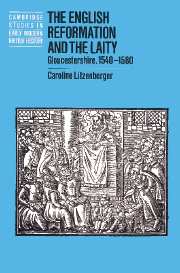Book contents
- Frontmatter
- Contents
- List of figures
- List of tables
- Acknowledgments
- Abbreviations and conventions
- Introduction
- 1 Setting the scene
- 2 Gloucestershire in the 1530s
- 3 The new diocese of Gloucester (1540–1546)
- 4 The advent of Edwardian Protestantism (1547–1553)
- 5 A return to the old religion (1553–1558)
- 6 The early years of Elizabeth's reign (1559–1569)
- 7 The clarification of the religious settlement (1570–1580)
- Conclusion
- Appendix A Sources and methodology
- Appendix B Results of wills analysis
- Appendix C Parish finances
- Bibliography
- Index
- Cambridge Studies in Early Modern British History
4 - The advent of Edwardian Protestantism (1547–1553)
Published online by Cambridge University Press: 23 November 2009
- Frontmatter
- Contents
- List of figures
- List of tables
- Acknowledgments
- Abbreviations and conventions
- Introduction
- 1 Setting the scene
- 2 Gloucestershire in the 1530s
- 3 The new diocese of Gloucester (1540–1546)
- 4 The advent of Edwardian Protestantism (1547–1553)
- 5 A return to the old religion (1553–1558)
- 6 The early years of Elizabeth's reign (1559–1569)
- 7 The clarification of the religious settlement (1570–1580)
- Conclusion
- Appendix A Sources and methodology
- Appendix B Results of wills analysis
- Appendix C Parish finances
- Bibliography
- Index
- Cambridge Studies in Early Modern British History
Summary
After years of religious ambivalence, the reign of Edward VI unequivocally ushered in English Protestantism, beginning with a Royal Visitation in 1547. Through a series of such visitations, royal proclamations and parliamentary acts, both the language and the imagery of worship were changed. During the first few years the swing to the new religion was fairly gradual, but there followed an abrupt shift to a much more vigorous enforcement of Protestantism. Bishop Wakeman presided over the diocese during the gradual phase, while Bishop Hooper was a key figure during the later, more active phase. Over the course of the reign, many churches whitewashed their walls and other painted surfaces to cover forbidden images, removed their rood lofts, lights and images, and began using the new Prayer Book, the Homilies and the English Bible. How quickly did these changes take place in Gloucestershire, and how widespread were they? Finally, how did the laity respond?
As official policy changed, so did that of John Wakeman, whose episcopate continued through the first two years of Edward's reign. Continuing to conform but approaching the enforcement of the new policies of Edwardian Protestantism with increased vigour, Wakeman conducted a visitation in 1548, in which he sought to abolish ‘superstitious abuse’ of religious ceremonies, ‘all images shrynes and the lyke thynges mysse used in tymes past’, all invocations to saints, and the use of lights before images. He also required every church to have ‘an honest pulpit sett in some conveniente place’. Beyond those stipulations, all of which were based on the Royal Injunctions of the previous year, Wakeman made the normal enquiries concerning the physical condition of parish buildings.
- Type
- Chapter
- Information
- The English Reformation and the LaityGloucestershire, 1540–1580, pp. 59 - 82Publisher: Cambridge University PressPrint publication year: 1997



